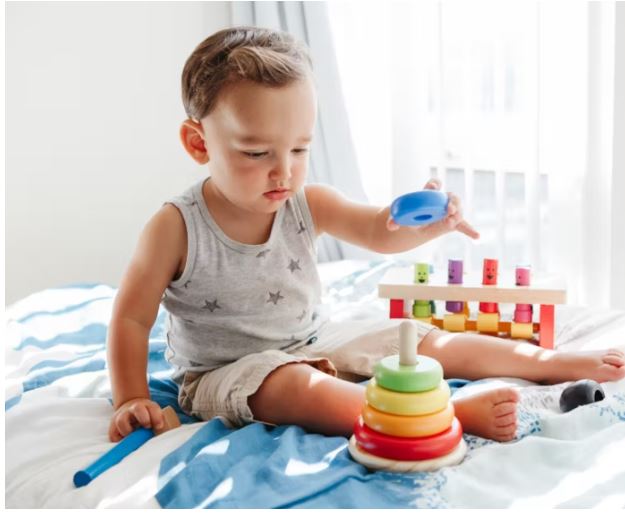In today’s rapidly evolving technological landscape, smart toys are emerging as a transformative force in early childhood education. These innovative toys, equipped with advanced features such as connectivity, interactive learning, and artificial intelligence (AI), are capturing the attention of modern parents.
They offer an exciting blend of fun and education, making learning an engaging and dynamic experience for toddlers. By integrating Montessori toys for 1 Year Olds into this tech-enhanced approach, parents can ensure a balanced and holistic developmental experience. This article explores the potential of smart toys and how they are reshaping the way we think about play and education for young children.
Understanding Smart Toys
Smart toys are designed to enhance playtime with interactive features that engage children in ways traditional toys cannot. They often include elements such as voice recognition, sensors, and connectivity to apps or the internet, allowing for a more immersive and personalized learning experience.
Unlike conventional toys, smart toys can adapt to a child’s developmental stage, providing activities that challenge and stimulate their cognitive and physical growth.
Benefits of Smart Toys for Toddlers
- Enhanced Learning: Smart toys are equipped with features that promote critical thinking, problem-solving, and motor skills development. For instance, interactive puzzles and games can help toddlers improve their hand-eye coordination and spatial awareness.
- Engagement and Motivation: These toys often come with fun rewards, sound effects, and animations that capture a child’s attention, making learning feel like play. This intrinsic motivation encourages children to explore and learn more enthusiastically.
- Personalized Learning: One of the most significant advantages of smart toys is their ability to adapt to a child’s learning pace. Through AI and machine learning algorithms, these toys can adjust the difficulty level of activities, ensuring that each child is challenged appropriately without feeling overwhelmed.
Integrating Smart Toys with Traditional Play
To create a well-rounded play environment, it’s essential to blend smart toys with traditional toys. Here are some strategies for parents and educators:
- Balancing Screen Time: Set reasonable limits on screen time to ensure that children have plenty of opportunities for physical play, creativity, and social interaction. A good rule of thumb is to limit screen time to no more than one hour per day for toddlers.
- Encouraging Hands-On Play: Complement smart toys with blocks, art supplies, and outdoor play equipment. This balance ensures that children develop a wide range of skills, from fine motor skills to social interaction.
- Supervised Play: Engage with your child during playtime to enhance their learning experience. Ask questions, join in their activities, and provide guidance when needed to help them make the most of their smart toys.
Popular Types of Smart Toys
- Interactive Storybooks: These books come to life with sound, music, and interactive elements, making storytelling more engaging and enhancing literacy skills.
- Educational Robots: Robots designed for toddlers teach basic coding, problem-solving, and robotics through fun, interactive play. These robots can respond to voice commands, follow paths, and perform simple tasks, sparking an interest in STEM (science, technology, engineering, and math).
- Learning Tablets and Apps: Tablets and apps tailored for young children offer a variety of educational games and activities. These tools can teach numbers, letters, shapes, and more through interactive and visually appealing content.
Best Practices for Using Smart Toys
- Setting Time Limits: While smart toys offer fantastic educational benefits, it’s important to balance screen time with other activities. Aim to limit screen time to no more than one hour a day and encourage a mix of screen-based and non-screen-based play.
- Supervised Play: Actively participate in your child’s playtime to provide guidance, support, and enrichment. This interaction enhances the learning experience and helps children understand the concepts being taught.
- Toy Rotation: To keep the play environment stimulating and prevent boredom, use a rotation system. This approach ensures that children have a variety of toys to explore, maintaining their interest and excitement.
Creating a Smart Toy Playroom
Designing a playroom that integrates smart toys with traditional toys can be both fun and beneficial. Here are some tips for creating a balanced play area:
- Defined Zones: Establish separate areas for tech-based and hands-on play. For example, set up a corner with smart toys and another area with building blocks and art supplies. This organization helps children easily switch between different types of play.
- Safety and Accessibility: Ensure that the playroom is safe, with all toys and equipment placed within easy reach of children. Use child-proofing measures to keep the space safe and secure.
- Incorporating Learning Stations: Set up interactive stations where children can engage in different activities, such as a reading nook with storybooks or a mini science lab with simple experiments. These stations encourage exploration and discovery.
Success Stories and Real-Life Examples
Many parents and educators have successfully integrated smart toys into their play routines, witnessing significant benefits in their children’s development. For instance, one parent noted that their child’s problem-solving skills and creativity soared after incorporating educational robots into their playtime. Another educator shared that students became more engaged and motivated during learning sessions when interactive storybooks and educational apps were introduced.
Conclusion
Smart toys are revolutionizing early childhood education, offering a blend of fun and learning that is both engaging and effective. By integrating smart toys with traditional play methods, parents and educators can create a dynamic and enriching environment that supports the holistic development of young children. Embracing the future of play, while maintaining a balance with classic toys and activities, can help foster a love of learning and exploration in toddlers.

